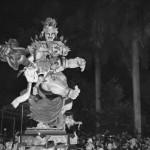Nyepi Day, or the day of silence in Bali this year falls on 17 March 2018, or exactly on the last date of the month. Balinese Hindu will flock beaches days before the day to clean the earth with offerings and prayers, while at night, the ogoh-ogoh parade will live up and ignite the island with noise and glorious shouts before a total silence the next day. It’s an observance that has been known by many people around the world. Today, in the spirit of welcoming Nyepi, we have noted 5 things that you might not know about this Balinese New Year celebration. These might surprise you.
1. A Village in Bali Celebrates Nyepi, Twice
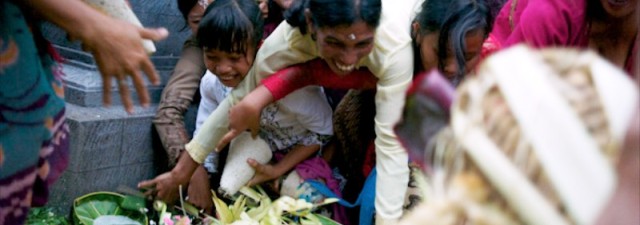
(The jorogan procession on Nyepi Kasa in Buahan Village. Photo credit: Anggara Mahendra)
In Buahan Village, Payangan, Gianyar regency, people do not only observe Nyepi for one time in a year, instead they observe it twice. Besides Nyepi Day, they also have Nyepi Kasa, a silent day that is only observed by people in this village on the first month of the Balinese calendar (4 months after the regular Nyepi Day) in which “kasa” means “first’”, hence the name of “Nyepi Kasa”.
Nyepi Kasa began centuries ago when the village suffered from deadly disease (known locally as gerubug). So, people in the village prayed to Gods to discontinue the plague until one villager finally gained a holy revelation and asserted that the village must conduct a silent day (Nyepi) on the first month of the Balinese calendar.
On Nyepi Kasa, the village is the only area that is silent in the island. No vehicles, no lights in sight, and the road to Kintamani that passes through this village will be closed down for a day. Unlike the regular Nyepi Day, this Nyepi Kasa has unique procession held a day before the silent day. In the morning there is a sacrifice of a calf in which the calf will be set free to walk but then slowly it will be stabbed until it bleeds and dies. The meat will be shared to all householders in the village. In the afternoon, there is a procession named, jorogan, in which women scramble and thrust at each other to grab the offerings that have been devoted by the Hindu priest. Although it sounds like a competition, they all will end up with laughter. To close the ritual, at night, ogoh-ogoh parade is held where it rounds the village for three times.
2. A Village in Bali Doesn’t Celebrate Nyepi, At All
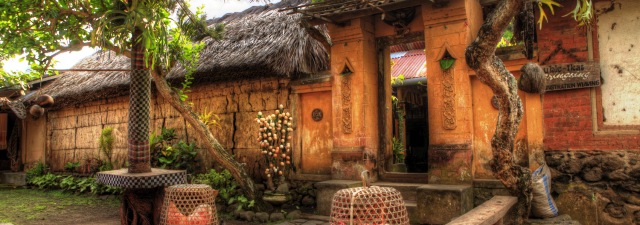
(Traditional house in Tenganan Village. Photo credit: Robin Nichols)
When most parts in Bali refrain physical activity on Nyepi Day, there’s actually one village in Bali that does not observe the day, at all. It’s Tenganan Village in Karangasem regency.
Tenganan is an ancient village where Bali Aga (Bali’s original tribe) lives. Bali Aga does not have the influence of Majapahit kingdom like most part of Bali, therefore, beside Nyepi, the village also doesn’t celebrate Galungan and Kuningan, two other most celebrated festival in the island that are originally brought by Majapahit kingdom. On the Nyepi Day, people in Tenganan will still be like in their usual day with lights on, but they still respect others Balinese who observe the day by not doing activity outside the village.
With that rarity, the village is often visited by tourists who want to know closer about their daily life such as their traditional houses and their strict policy that visitors must leave when the village gates are sealed each evening. Furthermore, Tenganan people respect their village rules, known as awig-awig, where marriage can be only among those within the village. That makes a villager who marries outside the village descendants will be not considered as the village native anymore. Their burial procession is also dissimilar to most Balinese Hindu. The dead man must be buried the day when they died, unlike most Balinese who seek certain date to precede burial. They also don’t carry out ngaben, the Balinese cremation ceremony.
3. A Village in Bali Celebrates Nyepi with a Mass Kissing Ritual
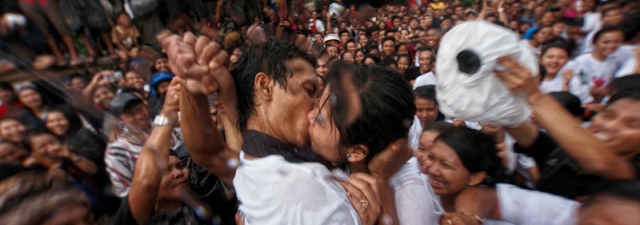
(People are cheering over two teenagers who are snatching kiss during omed-omedan procession in Sesetan Village, Denpasar. Photo credit: Henry Sudarman)
Yes, you read it right. A mass kissing ritual before Nyepi Day can be witnessed at Banjar Kaja, Sesetan Village, in Denpasar. It’s a century old ritual that can only be found in the village, where the village natives from 17 to 30 years old will gather on the village’s main road. Omed-omedan came from the word ‘omed’ which means ‘pull’, indicates how the event conducted.
Omed-omedan is originated about century ago when there was a strange incident in the village in which two pigs, male and female, strangely fighting in the village. That was believed to be a sign of negativity and believed if the ritual abstains in a year, a tragedy will happen. The ritual symbolizes a ceremony for the youths to express their joy, achieving positivity.
The ritual begins with prayer lead by Hindu priest. Participants will be separated into two groups; male and female. When the baleganjur troop starts playing, the Hindu leader is ready to signal the ritual. Both groups will meet in rush in the middle. The male group occasionally pulls the girls and immediately tries to snatch a kiss. They mostly will get to kiss on the cheek but for the lucky one, or the brave one, sometimes could even snatch a kiss on the lips. They all will end up wet as the people around them will throw water above the participants. Uniquely, the aftermath of this ritual not only ends until that. Sometimes, they end up as lovers, event go on into marriages in real life.
4. Ogoh-Ogoh is Only 30 Years Old
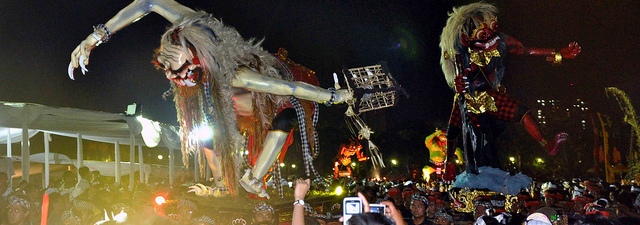
(Ogoh-ogoh parade in the night before the Nyepi day. Photo credit: ogiegxc)
According to the inscription of Trunyan A, Nyepi has been observed since 8 BC, making it an old tradition that long lasts until today. Ogoh-Ogoh (the huge paper mache) has very strong relation with the tradition of Nyepi in Bali. But did you know, although Nyepi is already centuries old, ogoh-ogoh is only 30 years old?
Yes, the huge paper mache that is inspired by demons with those scary looks firstly appeared in early 1980s, exactly in 1983. It’s at the time when Indonesian government declared Nyepi as a national holiday. The name of ogoh-ogoh was not originally used; instead people in Bali called it as ‘bhuta’ due to it resembles the looks of demons in Balinese Hindu beliefs. Afterward, the name ogoh-ogoh became popular with more people mentioned it as it derived from ‘ogah-ogah’ which means wiggling or shaking, represents how them are paraded. The rise of ogoh-ogoh in Bali came after it was featured on the 12th Bali Arts Festival where all eight regencies in Bali were invited to showcase their creation. Until then, ogoh-ogoh parade has now become a routine on Nyepi Day.
5. The Meaning of the Pecalang’s Uniform
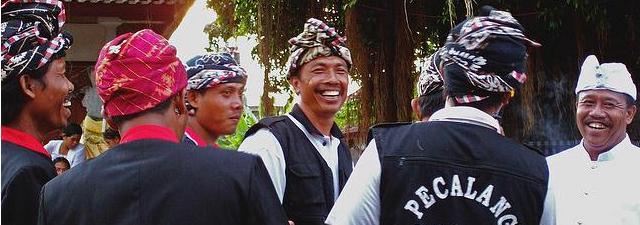
(A group of pecalangs guards Nyepi day to secure the observance goes well. Photo credit: Yesy)
Pecalang is the Balinese traditional guards who are created to maintain the security of each village in Bali, especially during Nyepi. Each village has its own pecalangs who will keep the security for the entire Nyepi to be safe. People can easily identify a pecalang by their uniform; a sarong (chessboards motif), white shirt, a black waistcoat, a head cloth (known as ‘udeng’) and sometimes a keris (dagger) affixed on the waist. It’s not a mere uniform, instead all of those attributes has each own meaning. The chessboards motif on the sarong for example, with white and black represents the opposition of good and devil in which both bearing into balance and harmony. The sarong is also can be seen on any statues of the gate temples in Bali, which loosely symbolizes guardian. The keris represents the readiness of the guards for any possible condition, in peaceful approach, rather than aggressive. As a whole it reflects that a pecalang main task is not only to control the security of the street during Nyepi but also keeping it silent and peaceful.
So how did you fare? Did you already know all these 5 trivia? Or do you know others things that are not known by many about Nyepi in Bali? Let’s share in the comment section!
More about Nyepi:
• Nyepi and its restrictions (Catur Bratha Penyepian)



